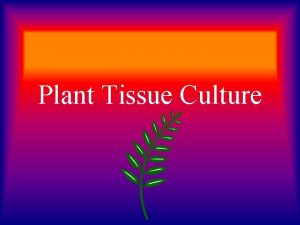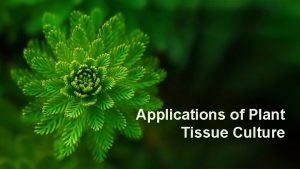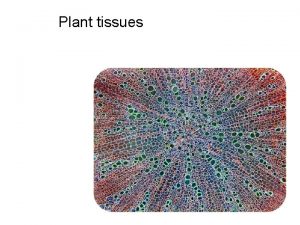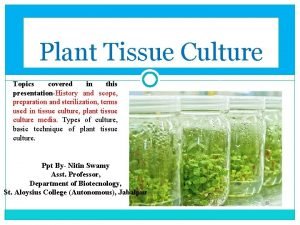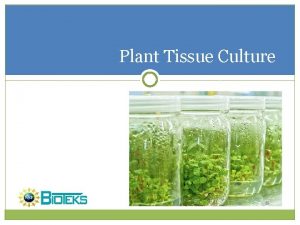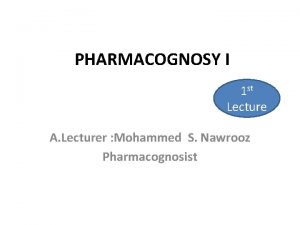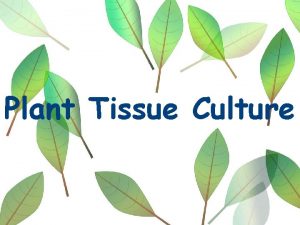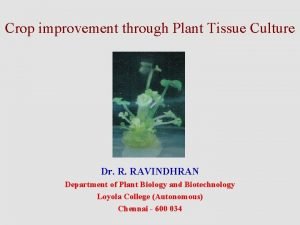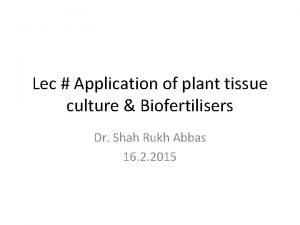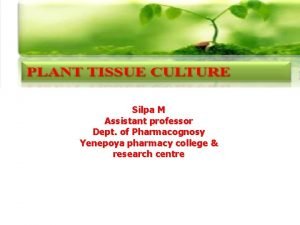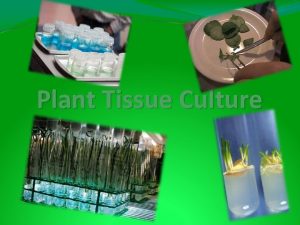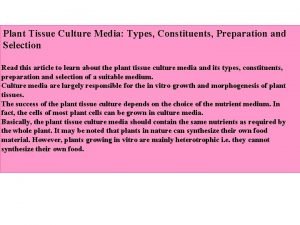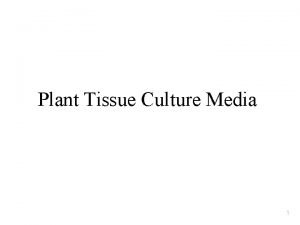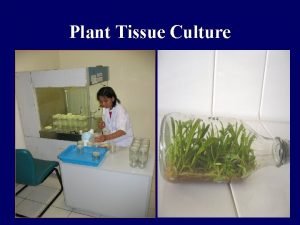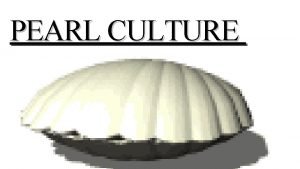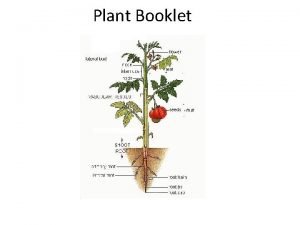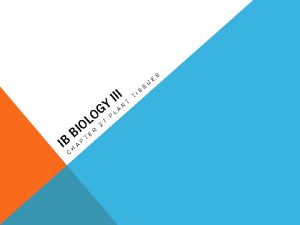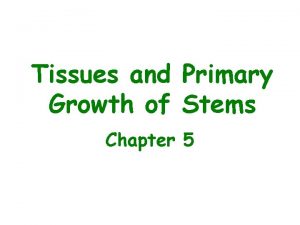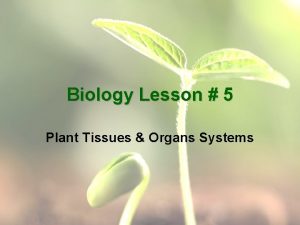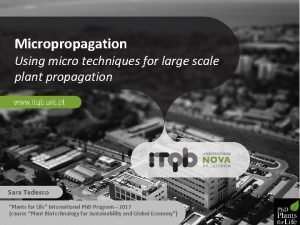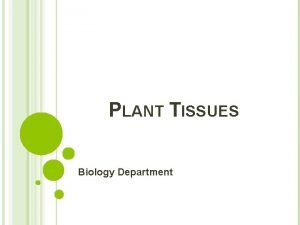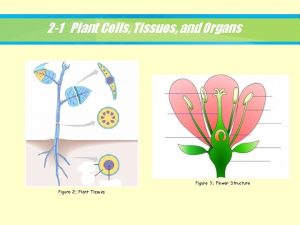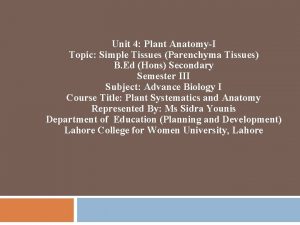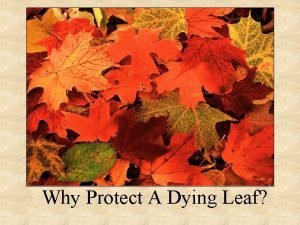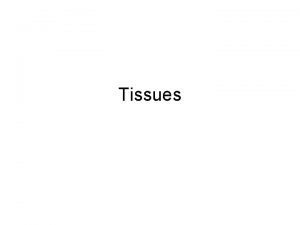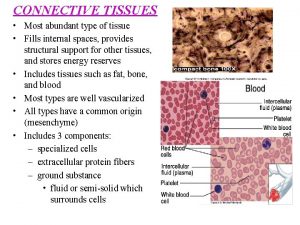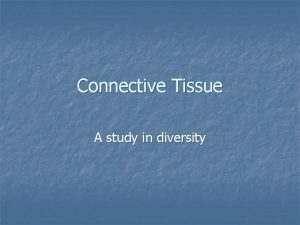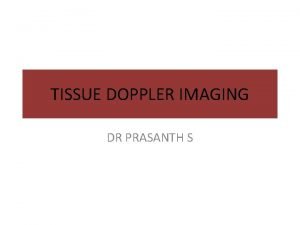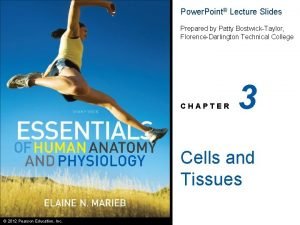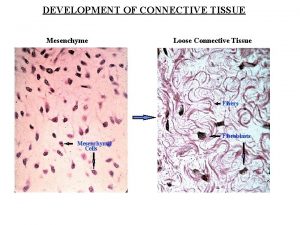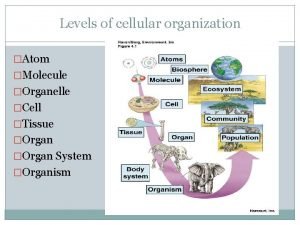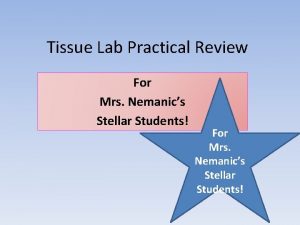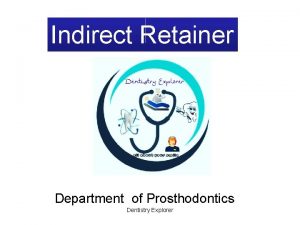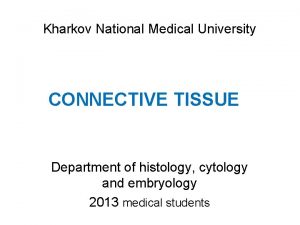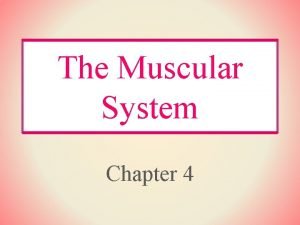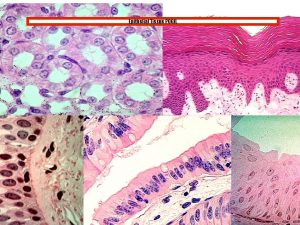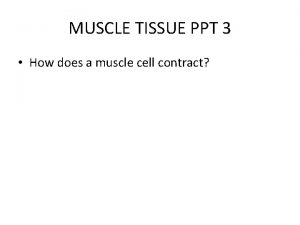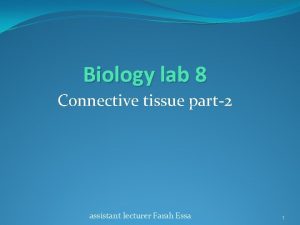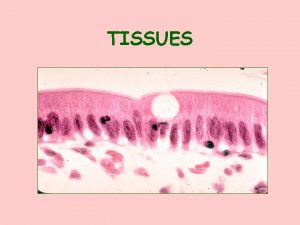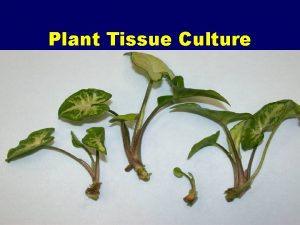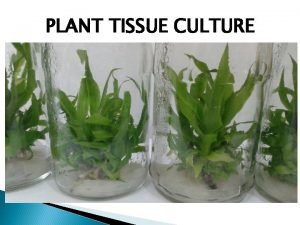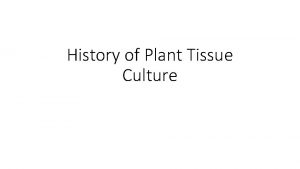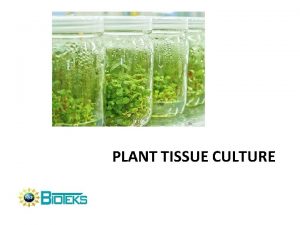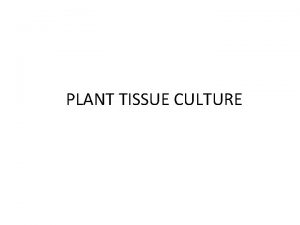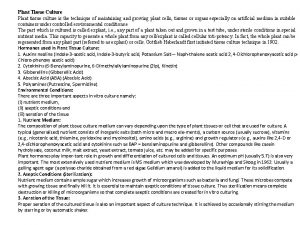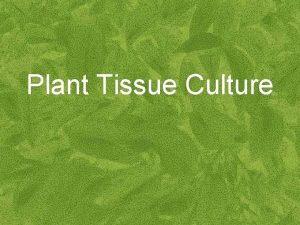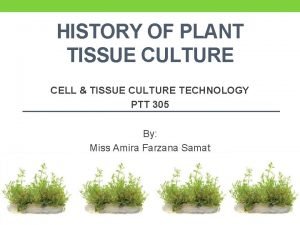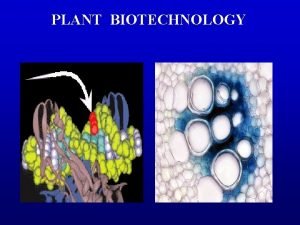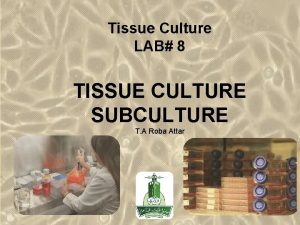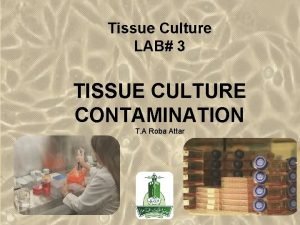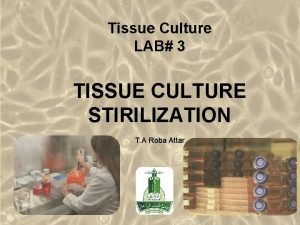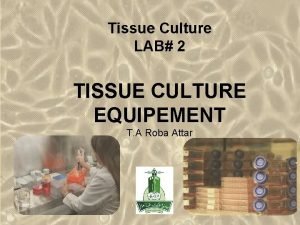Plant Tissue Culture What Is plant tissue culture



























![Somatic embryogenesis from Pro-embryonic masses (PEMs) + Auxin leads to high [Putrescine] PEM Development Somatic embryogenesis from Pro-embryonic masses (PEMs) + Auxin leads to high [Putrescine] PEM Development](https://slidetodoc.com/presentation_image/35f2dc24ff734c485db6c4d4fdb86bb3/image-28.jpg)
























































- Slides: 84

Plant Tissue Culture

What Is plant tissue culture? Or in vitro propagation? Or Micropropagation ?

Definition the culture of plant seeds, organs, explants, tissues, cells, or protoplasts on nutrient media under sterile conditions.

Basis for Plant Tissue Culture • Two Hormones Affect Plant Differentiation: – Auxin: Stimulates Root Development – Cytokinin: Stimulates Shoot Development • Generally, the ratio of these two hormones can determine plant development: – Auxin ↓Cytokinin = Root Development – Cytokinin ↓Auxin = Shoot Development – Auxin = Cytokinin = Callus Development

Control of in vitro culture Cytokinin Leaf strip Adventitious Shoot Root Callus Auxin


Factors Affecting Plant Tissue Culture • Growth Media – Minerals, Growth factors, Carbon source • Environmental Factors – Light, Temperature, Photoperiod • Explant Source – Types Usually, the younger, less differentiated the explant, the better for tissue culture – Genetics 1. Different species show differences in amenability to tissue culture 2. In many cases, different genotypes within a species will have variable responses to tissue culture; response to somatic embryogenesis has been transferred between melon cultivars through sexual hybridization

Choice of explant Desirable properties of an explant ü Easily sterilisable ü Juvenile ü Responsive to culture ü Shoot tips ü Axillary buds ü Seeds ü Hypocotyl (from germinated seed) ü Leaves

Media ü When you make an explant like an axillary bud, you remove it from the sources of many chemicals and have to re-supply these to the explants to allow them to grow. Shoot tip - Auxins and Gibberellins Leaves sugars, GAs Roots - water, vitamins mineral salts and cytokinins

Medium constituents ü Inorganic salt formulations ü Source of carbohydrate ü Vitamins ü Water ü Plant hormones - auxins, cytokinins, GA’s ü Solidifying agents ü Undefined supplements

Carbohydrates ü Plants in culture usually cannot meet their needs for fixed carbon. Usually added as sucrose at 2 -3% w/v. ü Glucose or a mixture of glucose and fructose is occasionally used. ü For large scale cultures, cheaper sources of sugars (corn syrup) may be used.

Photoautotrophic culture • Growth without a carbon source. Therefore need to boost photosynthesis. • High light intensities needed (90150 m. Mole/m 2/s) compared to normal (30 -50). • Usually increase CO 2 (1000 ppm) compared to normal 369. 4 ppm. • Much reduced level of contamination and plants are easier to transfer to the greenhouse.

Inorganic salt formulations ü Contain a wide range of Macro-elements (>mg/l) and microelements (<mg/l). ü A wide range of media are readily available as spray-dried powders. ü Murashige and Skoog Medium (1965) is the most popular for shoot cultures. ü Gamborgs B 5 medium is widely used for cell suspension cultures (no ammonium).

Vitamins ü A wide range of vitamins are available and may be used. ü Generally, the smaller the explant, the more exacting the vitamin requirement. ü A vitamin cocktail is often used (Nicotinic acid, glycine, Thiamine, pyridoxine). ü Inositol usually has to be supplied at much higher concentration (100 mg/l)

Plant hormones (Growth regulators) ü Auxins ü Cytokinins ü Gibberellic acids ü Ethylene ü Abscisic Acid ü “Plant Growth Regulator-like compounds”

Auxins ü Absolutely essential (no mutants known) ü Only one compound, Indole-3 -acetic acid. Many synthetic analogues (NAA, IBA, 2, 4 -D, 2, 4, 5 -T, Pichloram) - cheaper & more stable ü Generally growth stimulatory. Promote rooting. ü Produced in meristems, especially shoot meristem and transported through the plant in special cells in vascular bundles.

Cytokinins ü Absolutely essential (no mutants known) ü Single natural compound, Zeatin. Synthetic analogues Benyzladenine (BA), Kinetin. ü Stimulate cell division (with auxins). ü Promotes formation of adventitious shoots. ü Produced in the root meristem and transported throughout the plant as the Zeatin-riboside in the phloem.

Gibberellins (GA’s) • A family of over 70 related compounds, all forms of Gibberellic acid. • Commercially, GA 3 and GA 4+9 available. • Stimulate etiolation of stems. • Help break bud and seed dormancy. • Produced in young leaves.

Abscisic Acid (ABA) • Only one natural compound. • Promotes leaf abscission and seed dormancy. • Plays a dominant role in closing stomata in response to water stress. • Has an important role in embryogenesis in preparing embryos for desiccation. Helps ensure ‘normal’ embryos.

‘Plant Growth Regulator-like substances’ ü Polyamines - have a vital role in embryo development. ü Jasmonic acid - involved in plant wound responses. ü Salicylic acid. ü Not universally acclaimed as plant hormones since they are usually needed at high concentrations.

Undefined supplements ü Sources of hormones, vitamins and polyamines. ü e. g. Coconut water, sweetcorn extracts ü Not reproducible ü Do work.

Fundamental abilities of plants ü Totipotency the potential or inherent capacity of a plant cell to develop into an entire plant if suitable stimulated. It implies that all the information necessary for growth and reproduction of the organism is contained in the cell ü Dedifferentiation The capacity of mature cells to return to meristematic condition and development of a new growing point, followed by redifferentiation which is the ability to reorganize into new organs ü Competency the endogenous potential of a given cell or tissue to develop in a particular way

Type of in vitro culture ü Culture of intact plants (Seed orchid culture) ü Embryo culture (embryo rescue) ü Organ culture 1. 2. 3. 4. shoot tip culture Root culture Leaf culture anther culture ü Callus culture ü Cell suspension and single cell culture ü Protoplast culture

Breeding Applications of Tissue Culture ü Micropropagation ü Germplasm preservation ü Somaclonal variation ü Embryo culture ü Haploid & dihaploid production ü In vitro hybridization – protoplast fusion ü Plant genetic engineering

Micropropagation • Embryogenesis – Direct embryogenesis – Indirect embryogenesis • Organogenesis – Organogenesis via callus formation – Direct adventitious organ formation • Microcutting – Meristem and shoot tip culture – Bud culture

Somatic Embryogenesis

Somatic Embryogenesis ü The process of initiation and development of embryos or embryo-like structures from somatic cells ü The production of embryos from somatic or “nongerm” cells. ü Usually involves a callus intermediate stage which can result in variation among seedlings ü Not a common micro-propagation technique but is currently being used to produce superior pine seedlings
![Somatic embryogenesis from Proembryonic masses PEMs Auxin leads to high Putrescine PEM Development Somatic embryogenesis from Pro-embryonic masses (PEMs) + Auxin leads to high [Putrescine] PEM Development](https://slidetodoc.com/presentation_image/35f2dc24ff734c485db6c4d4fdb86bb3/image-28.jpg)
Somatic embryogenesis from Pro-embryonic masses (PEMs) + Auxin leads to high [Putrescine] PEM Development and cycling of Pro-embryonic masses E. g. Carrot, Monocots, some conifers Remove Auxin Polyamine Inter-convesions Single cells sloughed off the surface Putrescine to Spermidine to Spermine

Cleavage Polyembryony- conifers Cleavage lengthways Embryo Suspensor Normal Embyro Lateral division New embryos

Secondary embryo formation - Most dicots Abundant Secondary Embryos +Cytokinin Early embryo +Charcoal +ABA -Cytokinin

Embryo Fermentations ü Somatic Embryos may be produced profusely from leaves or zygotic embryos. ü For micropropagation, potentially phenomenally productive. ü Shear sensitivity is a problem. ü Maturation in liquid is a problem.

Somatic Embryos ü Tissue culture maintains the genetic of the cell or tissue used as an explant ü Tissue culture conditions can be modified to cause to somatic cells to reprogram into a bipolar structure ü These bipolar structures behave like a true embryo - called somatic embryos

Organogenesis

Organogenesis ü The process of initiation and development of a structure that shows natural organ form and/or function. ü the ability of non-meristematic plant tissues to form various organs de novo. ü the production of roots, shoots or leaves. ü These organs may arise out of pre-existing meristems or out of differentiated cells. ü This, like embryogenesis, may involve a callus intermediate but often occurs without callus.

Plant Organogenesis ü Indirect: – This pathway includes a callus stage. • Callus: Undifferentiated tissue that develops on or around an injured or cut plant surface or in tissue culture. ü Direct: – It bypasses a callus stage. The cells in the explant act as direct precursors of a new primordium • An organ or a part in its most rudimentary form or stage of development

Organogenesis ü Adventitious shoot formation is the de-novo development of shoots from cell clusters in the absence of pre-existing meristems. ü In some species (e. g. Saintpaulia), many shoots can be induced (3000 from one leaf). ü In other species (e. g. coffee), it may be necessary to induce an un-organised mass proliferation of cells (callus) prior to adventitious shoot formation.


Somatic Embryogenesis and Organogenesis • Both of these technologies can be used as methods of micro-propagation. • Not always desirable because they may not always result in populations of identical plants. • The most beneficial use of somatic embryogenesis and organogenesis is in the production of whole plants from a single cell (or a few cells).

Microcutting • This is a specialized form of organogenesis • It involves the production of shoots from preexisting meristems only. • Requires breaking apical dominance • Microcuttings can be one of three types: – Nodal – Shoot cultures – Clump division

Micropropagation • The art and science of plant multiplication in vitro • Usually derived from meristems (or vegetative buds) without a callus stage – Tends to reduce or eliminate somaclonal variation, resulting in true clones • Can be derived from other explant or callus (but these are often problematic)

Steps of Micropropagation • Stage 0 – Selection & preparation of the mother plant – sterilization of the plant tissue takes place • Stage I - Initiation of culture – explant placed into growth media • Stage II - Multiplication – explant transferred to shoot media; shoots can be constantly divided • Stage III - Rooting – explant transferred to root media • Stage IV - Transfer to soil – explant returned to soil; hardened off


Features of Micropropagation • Clonal reproduction – Way of maintaining heterozygozity • Multiplication Stage can be recycled many times to produce an unlimited number of clones – Routinely used commercially for many ornamental species, some vegetatively propagated crops • Easy to manipulate production cycles – Not limited by field seasons/environmental influences • Disease-free plants can be produced – Has been used to eliminate viruses from donor plants

Tissue Culture Applications • Micropropagation ü Germplasm preservation • Somaclonal variation • Embryo culture • Haploid & dihaploid production • In vitro hybridization – protoplast fusion • Industrial products from cell cultures • Plant genetic engineering

Germplasm Preservation ü Extension of micropropagation techniques q Two methods: 1. Slow growth techniques o ↓ Temp. , ↓ Light, media supplements (osmotic inhibitors, growth retardants), tissue dehydration o Medium-term storage (1 to 4 years) 2. Cryo-preservation o Ultra low temperatures o Stops cell division & metabolic processes o Very long-term (indefinite? )

Cryopreservation Requirements • Preculturing – Usually a rapid growth rate to create cells with small vacuoles and low water content • Cryoprotection – Glycerol, DMSO, PEG, to protect against ice damage and alter the form of ice crystals • Freezing – The most critical phase; one of two methods: • Slow freezing allows for cytoplasmic dehydration • Quick freezing results in fast intercellular freezing with little dehydration

Cryopreservation Requirements • Storage – Usually in liquid nitrogen (-196 o. C) to avoid changes in ice crystals that occur above -100 o. C • Thawing – Usually rapid thawing to avoid damage from ice crystal growth • Recovery – Thawed cells must be washed of cryo-protectants and nursed back to normal growth – Avoid callus production to maintain genetic stability

Tissue Culture Applications • Micropropagation • Germplasm preservation ü Somaclonal variation & mutation selection • Embryo Culture • Haploid & Dihaploid Production • In vitro hybridization – Protoplast Fusion • Industrial Products from Cell Cultures • Plant genetic engineering

Somaclonal Variation A general phenomenon of all plant regeneration systems that involve a callus phase • two general types of Somaclonal Variation: – Heritable, genetic changes (alter the DNA) – Stable, but non-heritable changes (alter gene xpression, epigenetic)

Somaclonal Breeding Procedures • Use plant cultures as starting material – Idea is to target single cells in multi-cellular culture – Usually suspension culture, but callus culture can work • Optional: apply physical or chemical mutagen • Apply selection pressure to culture – Target: very high kill rate, you want very few cells to survive, so long as selection is


Requirements for Somaclonal Breeding • Effective screening procedure – Most mutations are deleterious • With fruit fly, the ratio is ~800: 1 deleterious to beneficial – Most mutations are recessive • Must screen M 2 or later generations • Consider using heterozygous plants? – But some say you should use homozygous plants to be sure effect is mutation and not natural variation • Haploid plants seem a reasonable alternative if possible – Very large populations are required to identify desired mutation: • Can you afford to identify marginal traits with replicates & statistics? Estimate: ~10, 000 plants for single gene mutant • Clear Objective – Can’t expect to just plant things out and see what happens; relates to having an effective screen – This may be why so many early experiments failed

Tissue Culture Applications • Micropropagation • Germplasm preservation • Somaclonal variation ü Embryo culture • Haploid & dihaploid production • In vitro hybridization – protoplast fusion • Industrial products from cell cultures • Plant genetic engineering

Embryo Culture ü Embryo culture developed from the need to rescue embryos (embryo rescue) from wide crosses where fertilization occurred, but embryo development did not occur ü These techniques have been further developed for the production of plants from embryos developed by non-sexual methods (haploid production discussed later)

Embryo Culture Uses • Rescue F 1 hybrid from a wide cross • Overcome seed dormancy, usually with addition of hormone to media (GA) • To overcome immaturity in seed – To speed generations in a breeding program – To rescue a cross or self (valuable genotype) from dead or dying plant


Tissue Culture Applications • Micropropagation • Germplasm preservation • Somaclonal variation • Embryo culture ü Haploid & dihaploid production • In vitro hybridization – protoplast fusion • Industrial products from cell cultures • Plant genetic engineering

Haploid Plant Production • Embryo rescue of inter-specific crosses – Creation of alloploids (e. g. triticale) – Bulbosum method • Anther culture/Microspore culture – Culturing of Anthers or Pollen grains (microspores) – Derive a mature plant from a single microspore • Ovule culture – Culturing of unfertilized ovules (macrospores) – Sometimes “trick” ovule into thinking it has

Bulbosum Method Hordeum vulgare Barley 2 n = 2 X = 14 X ↓ Hordeum bulbosum Wild relative 2 n = 2 X = 14 Embryo Rescue Haploid Barley 2 n = X = 7 H. Bulbosum chromosomes eliminated ü This was once more efficient than microspore culture in creating haploid barley ü Now, with an improved culture media (sucrose replaced by maltose), microspore culture is much more efficient (~2000 plants per 100 anthers)

Anther/Microspore Culture

Anther/Microspore Culture Factors • Genotype – As with all tissue culture techniques • Growth of mother plant – Usually requires optimum growing conditions • Correct stage of pollen development – Need to be able to switch pollen development from gametogenesis to embryogenesis • Pretreatment of anthers – Cold or heat have both been effective • Culture media – Additives, Agar vs. ‘Floating’

Ovule Culture for Haploid Production • Essentially the same as embryo culture – Difference is an unfertilized ovule instead of a fertilized embryo • Effective for crops that do not yet have an efficient microspore culture system – e. g. : melon, onion • In the case of melon, you have to “trick” the fruit into developing by using irradiated pollen, then xray the immature seed to find developed ovules

What do you do with the haploid? • Weak, sterile plant • Usually want to double the chromosomes, creating a di-haploid plant with normal growth & fertility • Chromosomes can be doubled by – Colchicine treatment – Spontaneous doubling • Tends to occur in all haploids at varying levels • Many systems rely on it, using visual observation to detect spontaneous di-haploids • Can be confirmed using flow cytometry

Specific Examples of DH uses • Evaluate fixed progeny from an F 1 – Can evaluate for recessive & quantitative traits – Requires very large di-haploid population, since no prior selection – May be effective if you can screen some qualitative traits early • For creating permanent F 2 family for molecular marker development • For fixing inbred lines (novel use? ) – Create a few di-haploid plants from a new inbred prior to going to Foundation Seed (allows you to uncover unseen off-types) • For eliminating inbreeding depression (theoretical) – If you can select against deleterious genes in culture, and screen very large populations, you may be able to eliminate or reduce inbreeding depression

Tissue Culture Applications • Micropropagation • Germplasm preservation • Somaclonal variation • Embryo culture • Haploid & dihaploid production ü In vitro hybridization – protoplast fusion • Industrial products from cell cultures • Plant genetic engineering

Protoplasts • Created by degrading the cell wall using enzymes • Very fragile, can’t be pipette ü Mechanical method ü Enzymatic method

Protoplast Fusion • Protoplast can be induced to fuse with one another: – Electrofusion: A high frequency AC field is applied between 2 electrodes immersed in the suspension of protoplasts- this induces charges on the protoplasts and causes them to arrange themselves in lines between the electrodes. They are then subject to a high voltage discharge which causes them membranes to fuse where they are in contact. – Polyethylene glycol (PEG): causes agglutination of many types of small particles, including protoplasts which fuse when centrifuged in its presence – Addition of calcium ions at high p. H values

Uses for Protoplast Fusion • Combine two complete genomes – Another way to create allopolyploids • Partial genome transfer – Exchange single or few traits between species – May or may not require ionizing radiation • Genetic engineering – Micro-injection, electroporation, Agrobacterium • Transfer of organelles – Unique to protoplast fusion – The transfer of mitochondria and/or chloroplasts between species

Possible Result of Fusion of Two Genetically Different Protoplasts = chloroplast = mitochondria Fusion = nucleus heterokaryon cybrid hybrid cybrid

Identifying Desired Fusions • Complementation selection –Can be done if each parent has a different selectable marker (e. g. antibiotic or herbicide resistance), then the fusion product should have both markers • Fluorescence-activated cell sorters –First label cells with different fluorescent markers; fusion product should have both markers • Mechanical isolation –Tedious, but often works when you start with different cell types • Mass culture –Basically, no selection; just regenerate everything and then screen for desired traits

Example of Protoplast Fusion ü Protoplast fusion between male sterile cabbage and normal cabbage was done, and cybrids were selected that contained the radish mitochondria and the cabbage chloroplast ü Current procedure is to irradiate the cytoplasmic donor to eliminate nuclear DNA – routinely used in the industry to re-create male sterile brassica crops

Tissue Culture Applications • Micropropagation • Germplasm preservation • Somaclonal variation • Embryo culture • Haploid & dihaploid production • In vitro hybridization – protoplast fusion ü Industrial products from cell cultures • Plant genetic engineering

Industrial Applications • Secondary metabolites produced by plants – Alkaloids, Terpenoids, Steroids, Anthocyanins, Anthraquinones, Polyphenols • Often unclear function in the plant • Often restricted production (specific species, tissue or organ) • Many are commercially valuable • Cell culture techniques allow large-scale production of specific secondary metabolites

Cell culture systems ü Callus ü Cell suspension culture Callus • An unorganised mass of cells • Equimolar amounts of auxin and cytokinin stimulate cell division

Cell suspension culture ü When callus pieces are agitated in a liquid medium, they tend to break up. ü Suspensions are much easier to bulk up than callus since there is no manual transfer or solid support.

Introduction of callus into suspension ü ‘Friable’ callus goes ü Removal of large cell easily into suspension. aggregates by sieving. – 2, 4 -D ü Plating of single cells – Low cytokinin and small cell – semi-solid medium aggregates - only – enzymic digestion viable cells will grow with pectinase and can be re– blending introduced into suspension.

Introduction into suspension Sieve out lumps 1 2 Initial high density Pick off growing high producers + Subculture and sieving Plate out

Growth kinetics ü Initial lag dependent on dilution ü Exponential phase (dt 1 -30 d) ü Linear/deceleration phase (declining nutrients) ü Stationary (nutrients exhausted) 3 2 1 4

Characteristics of plant cells • Large (10 -100 μM long) • Tend to occur in aggregates • Shear-sensitive • Slow growing • Easily contaminated • Low oxygen demand • Will not tolerate anaerobic conditions • Can grow to high cell densities (>300 g/l fresh weight). • Can form very viscous solutions

Tissue Culture Applications • Micropropagation • Germplasm preservation • Somaclonal variation & mutation selection • Embryo culture • Haploid & dihaploid production • In vitro hybridization – protoplast fusion • Industrial products from cell cultures ü Plant genetic engineering

Plant genetic engineering • Overview of • How to get genes into requirements for plant cells to give genetic transformation transformed cells • Development of GM • How to get a plant foods back from a single transformed cell • Genes for crops • Benefits of GM crops, especially in developing countries

Requirements for plant genetic transformation • Trait that is encoded by a single gene • A means of driving expression of the gene in plant cells (Promoters and terminators) • Means of putting the gene into a cell (Vector) • A means of selecting for transformants • Means of getting a whole plant back from the single transformed cell

Photo of agro – crown gall? Gene gun Crown gall from Agrobacterium

Plasmid Vector
 Plant tissue culture terminology
Plant tissue culture terminology Conclusion for tissue culture
Conclusion for tissue culture Helianthus stem
Helianthus stem What is callus culture
What is callus culture Tissue culture applications
Tissue culture applications Application of pharmacognosy
Application of pharmacognosy Plant tissue culture definition
Plant tissue culture definition Plant tissue culture
Plant tissue culture What are the advantages of biofertilizers
What are the advantages of biofertilizers Applications of plant tissue culture
Applications of plant tissue culture Perforation plates
Perforation plates African violet tissue culture
African violet tissue culture Tissue culture media types
Tissue culture media types Macronutrients and micronutrients in plants
Macronutrients and micronutrients in plants Seed culture ppt
Seed culture ppt Types of pearl culture
Types of pearl culture Which tissue transports water around a plant?
Which tissue transports water around a plant? Plant tissue
Plant tissue Peta konsep
Peta konsep Ground tissue plant
Ground tissue plant Vascular cambium
Vascular cambium Plant tissue and organs
Plant tissue and organs Micropropagation
Micropropagation What is ground tissue in plants
What is ground tissue in plants Tissue meaning in biology
Tissue meaning in biology Change of gases
Change of gases Agranulocutes
Agranulocutes Vascular tissue
Vascular tissue Plant ground tissue
Plant ground tissue Parenchyma tissue
Parenchyma tissue Plant ground tissue
Plant ground tissue Folk cultures are spread primarily by
Folk cultures are spread primarily by Batch culture vs continuous culture
Batch culture vs continuous culture Carpet culture method
Carpet culture method Surface culture deep culture and esol
Surface culture deep culture and esol Stroke culture method
Stroke culture method Stab culture and stroke culture
Stab culture and stroke culture Fed-batch
Fed-batch Folk culture and popular culture venn diagram
Folk culture and popular culture venn diagram Pop culture examples
Pop culture examples Carpet culture microbiology
Carpet culture microbiology Folk culture and popular culture venn diagram
Folk culture and popular culture venn diagram Characteristics of collectivism
Characteristics of collectivism Sub culture group
Sub culture group Sociologists define a symbol as
Sociologists define a symbol as Laying the foundation for a quality culture
Laying the foundation for a quality culture Inert organizational culture
Inert organizational culture Difference between american and indian culture
Difference between american and indian culture Plant introduction in plant breeding
Plant introduction in plant breeding Tronsmo plant pathology and plant diseases download
Tronsmo plant pathology and plant diseases download Objective of plant breeding
Objective of plant breeding Tronsmo plant pathology and plant diseases download
Tronsmo plant pathology and plant diseases download Plant introduction in plant breeding
Plant introduction in plant breeding Tronsmo plant pathology and plant diseases download
Tronsmo plant pathology and plant diseases download Muscle tissue where is it found
Muscle tissue where is it found Layers of epithelial tissue
Layers of epithelial tissue Most abundant type of tissue in the body
Most abundant type of tissue in the body Connective tissue
Connective tissue Milady nail structure and growth
Milady nail structure and growth What do trophic levels represent
What do trophic levels represent Ground tissue definition
Ground tissue definition Tissue doppler imaging
Tissue doppler imaging Connective tissue disease adalah
Connective tissue disease adalah Connective tissue in bone marrow
Connective tissue in bone marrow Function of muscular tissue
Function of muscular tissue Dr ian smith injury management consultant
Dr ian smith injury management consultant Fibroelastic connective tissue
Fibroelastic connective tissue Connective tissue fiber
Connective tissue fiber Processes of neuron
Processes of neuron Nervous tissue diagram
Nervous tissue diagram Characteristics of the kingdom plantae
Characteristics of the kingdom plantae Atom-molecule-cell-organ system-organelle
Atom-molecule-cell-organ system-organelle Connective tissue lab practical
Connective tissue lab practical Indirect retainer rpd
Indirect retainer rpd Embryonic connective tissue
Embryonic connective tissue Lymphatic system organs and functions
Lymphatic system organs and functions The muscular system chapter 4
The muscular system chapter 4 Jones and bartlett learning
Jones and bartlett learning What is this tissue
What is this tissue Epithelial tissue pogil
Epithelial tissue pogil Tropomyosin muscle contraction
Tropomyosin muscle contraction Where is myeloid tissue found
Where is myeloid tissue found Loose connective tissue
Loose connective tissue Blood tissue
Blood tissue Ecological importance of cnidarians
Ecological importance of cnidarians
